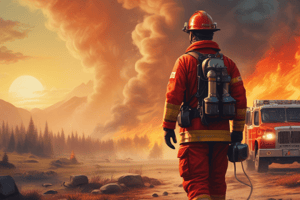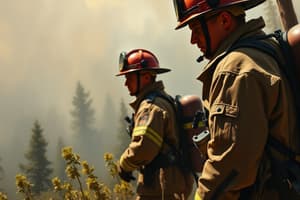Podcast
Questions and Answers
List the 18 watch outs.
List the 18 watch outs.
- Fire not scouted and sized up 2. In country not seen in daylight 3. Safety zones and escape routes not identified 4. Unfamiliar with weather and local factors influencing fire behavior 5. Uninformed on strategy, tactics, and hazards 6. Instructions and assignments not clear 7. No communication link with crew members and supervisors 8. Constructing line without a safe anchor point 9. Building fireline downhill with fire below 10. Attempting frontal assault on fire 11. Unburned fuel between you and the fire 12. Cannot see main fire; not in contact with someone who can 13. On a hillside where rolling material can ignite fuel below 14. Weather becoming hotter and drier 15. Wind increases and/or changes direction 16. Getting frequent spot fires across line 17. Terrain and fuels make escape to safety zones difficult 18. Taking a nap near fireline.
List 10 Standard Firefighting Orders.
List 10 Standard Firefighting Orders.
- Keep informed on weather conditions and forecast 2. Know what your fire is doing at all times 3. Base all actions on current and expected behavior of the fire 4. Identify escape routes and safety zones and make them known 5. Post lookouts when there is possible danger 6. Be alert, keep calm, think clearly, and act decisively 7. Maintain prompt communications with your forces, your supervisor, and adjoining forces 8. Give clear instructions and be sure they are understood 9. Maintain control of your forces at all times 10. Fight fire aggressively, having provided for safety first.
Identify nine parts of a fire.
Identify nine parts of a fire.
(1) Origin, (2) Head, (3) Flank, (4) Rear/Heel, (5) Perimeter, (6) Finger, (7) Pocket, (8) Island, (9) Spot Fire.
What is the location where the fire started called?
What is the location where the fire started called?
What part of the fire shows the direction in which it is burning?
What part of the fire shows the direction in which it is burning?
What is the term for the sides of the fire that are parallel to the main direction of spread?
What is the term for the sides of the fire that are parallel to the main direction of spread?
What is the opposite of the head of the fire called?
What is the opposite of the head of the fire called?
What is the boundary or edge of the fire known as?
What is the boundary or edge of the fire known as?
What do you call a narrow strip that burns away from the main part of the fire?
What do you call a narrow strip that burns away from the main part of the fire?
What is an unburned area between the main fire and any fingers called?
What is an unburned area between the main fire and any fingers called?
What is an area of unburned fuel inside the fire perimeter called?
What is an area of unburned fuel inside the fire perimeter called?
What type of burning area is outside the main fire perimeter and often caused by wind-blown embers?
What type of burning area is outside the main fire perimeter and often caused by wind-blown embers?
Name nine fire behavior terms.
Name nine fire behavior terms.
What is smoldering?
What is smoldering?
What does creeping fire refer to?
What does creeping fire refer to?
What is running fire?
What is running fire?
What does backing fire mean?
What does backing fire mean?
What is spotting in fire behavior?
What is spotting in fire behavior?
What does torching refer to in fire behavior?
What does torching refer to in fire behavior?
What is crowning in fire behavior?
What is crowning in fire behavior?
What does blowup refer to?
What does blowup refer to?
Name five other useful firefighting terms.
Name five other useful firefighting terms.
What is a Control Line?
What is a Control Line?
What is a Fireline?
What is a Fireline?
What is an Anchor Point?
What is an Anchor Point?
What does Mop-up refer to?
What does Mop-up refer to?
How is the size of the fire classified?
How is the size of the fire classified?
What are the four main types of crews commonly used in initial attack and extended attack?
What are the four main types of crews commonly used in initial attack and extended attack?
Name 4 common denominators of fire behavior on fatal and near-fatal fires.
Name 4 common denominators of fire behavior on fatal and near-fatal fires.
Safety zones must be pre-located to avoid:
Safety zones must be pre-located to avoid:
What type of fuel does a drip torch use?
What type of fuel does a drip torch use?
What are the three sides of the fire triangle?
What are the three sides of the fire triangle?
What factors influence fire line construction?
What factors influence fire line construction?
What are the five methods of attack?
What are the five methods of attack?
What is Direct Attack?
What is Direct Attack?
What does Indirect Attack mean?
What does Indirect Attack mean?
What is Hot Spotting?
What is Hot Spotting?
What does Cold Trailing refer to?
What does Cold Trailing refer to?
What is Burnout?
What is Burnout?
What is the purpose of a cup trench?
What is the purpose of a cup trench?
List 6 methods of communication.
List 6 methods of communication.
List some examples of natural control lines.
List some examples of natural control lines.
List some examples of a man-made control line.
List some examples of a man-made control line.
What does LCES stand for?
What does LCES stand for?
What is the difference between safety zones and deployment sites?
What is the difference between safety zones and deployment sites?
List 5 PPE items.
List 5 PPE items.
Who is in charge of a fire?
Who is in charge of a fire?
List 3 hand tools.
List 3 hand tools.
How much space is necessary for constructing line and why?
How much space is necessary for constructing line and why?
List 2 firing devices used in wildland fire.
List 2 firing devices used in wildland fire.
List 2 hazards when using a fusee in the field.
List 2 hazards when using a fusee in the field.
What is the best method for searching for hot spots?
What is the best method for searching for hot spots?
List 3 weather factors that influence firefighters' ability to fight fire.
List 3 weather factors that influence firefighters' ability to fight fire.
List 3 factors that reduce judgement, alertness, and decision-making in firefighters.
List 3 factors that reduce judgement, alertness, and decision-making in firefighters.
List the 5 steps of the risk management process.
List the 5 steps of the risk management process.
What is the purpose of a fire shelter?
What is the purpose of a fire shelter?
When is it okay for fireline personnel not to carry a fire shelter?
When is it okay for fireline personnel not to carry a fire shelter?
How often should fire shelters be inspected?
How often should fire shelters be inspected?
What items should be taken into a deployed fire shelter?
What items should be taken into a deployed fire shelter?
What are the characteristics of a good fire shelter deployment area?
What are the characteristics of a good fire shelter deployment area?
What is the purpose of taking water into a deployed fire shelter?
What is the purpose of taking water into a deployed fire shelter?
Where should the fuel be placed when digging line?
Where should the fuel be placed when digging line?
Should PPE be changed if it comes in contact with retardant?
Should PPE be changed if it comes in contact with retardant?
How many feet are in a chain?
How many feet are in a chain?
What is a tanker?
What is a tanker?
Where is the fire most intense?
Where is the fire most intense?
What 3 things must be present for effective communication to take place?
What 3 things must be present for effective communication to take place?
List 3 types of hose lays.
List 3 types of hose lays.
List the Wildland Urban Interface watch outs.
List the Wildland Urban Interface watch outs.
Flashcards are hidden until you start studying
Study Notes
Wildland Firefighter Training Key Concepts
- 18 Watch Outs: Essential safety considerations include unscouted fire areas, unclear communication, and escape routes not identified.
- 10 Standard Firefighting Orders: Guidelines stress maintaining awareness of fire conditions, communications, and safety prioritization.
- Nine Parts of a Fire: Key components include Origin, Head, Flank, Rear/Heel, Perimeter, Finger, Pocket, Island, and Spot Fire, each playing a crucial role in understanding fire dynamics.
Fire Behavior Terms
- Fire Triangle: Three critical elements that sustain fire: oxygen, heat, and fuel.
- Fire Movement Terms: Includes Smoldering (slow, flame-less), Creeping (low flame), Running (rapid spread), Backing (against wind), Spotting (embers), Torching (tree tops), Crowning (top spread), Blowup (sudden intensity increase).
Control Lines and Safety
- Control Lines: Natural or man-made barriers to contain fire; examples include water bodies and constructed clearings.
- Safety Zones vs Deployment Site: Safety zones protect from fire danger, while deployment sites may be near active hazards.
- LCES: A system highlighting Lookouts, Communications, Escape Routes, and Safety Zones for wildfire operations.
Equipment and Techniques
- PPE Items: Essential personal protective equipment includes hard hats, gloves, Nomex shirts, fire boots, and trousers.
- Drip Torch Fuel: Combines gas and diesel for effective ignition, balancing burn rate.
- Methods of Attack: Various approaches include Direct, Indirect, Cold Trailing, Hot Spotting, and Burnout for fire management.
Risk Management and Safety
- Risk Management Process: Steps include Situational Awareness, Hazard Assessment, Hazard Control, Decision Point, and Evaluation.
- Fire Shelter: Designed for radiant heat reflection and cooler air; should always be carried by personnel as a precaution.
Communication in Firefighting
- Effective Communication: Requires a sender, receiver, and an exchange of information for clarity in operations.
Wildland Urban Interface Challenges
- Watch Outs in Interface: Pay attention to wooden structures, poor access routes, inadequate water supply, and potential for extreme fire behavior near residential areas.
Additional Firefighting Considerations
- Fire Investigation: Constant monitoring of fire behavior, environmental conditions, and prediction of changes crucial for effective operation and safety.
- Hot Spots Identification: Best methods include gridding to locate remaining heat.
- Deployment Area Characteristics: Seek low points, ensure build-up and protection from heat, and maintain proximity to crew for optimal safety while using shelters.
Hazards and Equipment Usage
- Fusee Hazards: Potential risks include bright burn and hot drips; handle with caution.
- Fireline Construction: Requires adequate space (10 feet) to ensure crew safety during operations.
Studying That Suits You
Use AI to generate personalized quizzes and flashcards to suit your learning preferences.




